There are a few classic story lines of Sesame Street that you never forget: Cookie Monster can’t control his appetite, Oscar the Grouch doesn’t like to socialize, and Bert loves two things: oatmeal and pigeons.
Bert loved the bird so much that he had a pet pigeon named Bernice who often appeared at his side to join him in counting to ten and reciting the alphabet (number seven always tripped her up and she couldn’t really get past the letter “c”). Bert even made the classic dance video “Doin’ The Pigeon” in honor of his avian friend. (If you have five minutes, check it out on YouTube and be transported back to your childhood). Before he busts a move, Bert exclaims, “Now watch how these pigeons move…look at the neck, look at ‘em move, look at those feet! I feel these pigeons are really unusually intelligent birds.”
Bert’s unwavering devotion to the bird family Columbidae (pigeons and doves, of which there are over 300 species) was charming when you were dancing along with him as a kid in your footie pajamas, but now that you’ve grown up and have to encounter pigeons on a daily basis in the park, on the street and maybe, if you are incredibly unlucky, in and around your building, you realize Bert was unusually strange for having such an affection for these sometimes messy creatures.
Pigeons Past
Pigeons weren’t always city-dwellers. Joshua Engel, a research assistant in the Integrative Research Center at Chicago’s Field Museum explains, “Pigeons evolved to nest on cliffs, which helped them adapt to nesting on pseudo-cliffs, places like bridges, underpasses, and buildings. The pigeons that we have in the United States are a domesticated breed of pigeon, so they are well-suited to live around people.”
And, as Vanessa A. Williams, scientific media coordinator, zoologist and animal behavior specialist at Wild Goose Chase Migratory Bird Management of Chicago Ridge, Illinois and Brookfield, Wisconsin explains, “Pigeons have been co-evolving with humans for thousands of years. They are extremely adaptable and can easily live off of our garbage and leavings. In addition to being kept captive for messenger and food purposes, feeding 'wild' pigeons is an activity that has been around for centuries. These birds have been tamed, and possibly even changed as a species, by these actions and they have learned that people provide a bountiful food source.”
“Pigeons can also breed year-round if provided proper nesting areas,” Williams continues, “and our buildings offer many nooks and crannies out of the elements where they can nest safely and comfortably. Lastly, humans have exterminated most of the natural predators in their cities that prey on pigeons, creating a wonderfully safe environment for them.”
The Blue Bird of...Disease?
While we can give props to pigeons for adapting, surviving and thriving, they definitely get no points at all for hygiene. As Richard Selzer, president of Avian Flyaway, Inc. in Rockwall, Texas points out, “Bird roosting produces the same filth that any unsanitary area does.” And we're talking serious filth: a single pigeon can produce up to 25 pounds of feces each year, and there are estimated to be over one million pigeons calling New York City home at any given time. All those birds (and all that mess) make for a potentially serious situation that goes beyond perching in inconvenient places and flies right into dangerous territory.
“Bird droppings and nesting material can carry 60 different transmittable diseases,” says Scott Seifert, sales director at Smithereen Pest Management Services of Niles, Illinois and Kansas City, Missouri. “Droppings are acidic, and can eat through paint and building materials. They can cause slip-and-all accidents that can lead to personal injury and lawsuits and droppings in excess may violate health codes and result in fines or legal actions.”
And in addition to the very real health and legal consequences of a bird-ridden property, anyone trying to sell a unit or welcome a new resident certainly wouldn’t want a gang of pigeons lurking around. Droppings on sidewalks, awnings, steps, etc. might scare away potential interest in your co-op building or HOA before the buyer even steps foot inside. The damage droppings can do to building facades can be unsightly and expensive to correct.
Shoo!
If your building is suddenly besieged, there are a number of steps you can take to curb the invasion before bringing in the pros. These options depend largely on the type of building you have and the species of bird involved, but across the board, an ounce of prevention is worth a pound of guano. “Buildings and their operators can try various harassment methods…like “Bird Chase Sonic,” a device that amplifies recorded species-specific distress calls,” says Arthur Katz, president of Knockout Pest Control in Uniondale, New York. Katz also recommends controlling food sources, keeping a lid on “garbage, open dumpsters, pet food left outside, and people who feed pigeons are key first starts.” It is possible that once you eliminate their dinner, the birds will take their business elsewhere.
Williams adds that “finding and repairing any holes in the building and keeping ventilation intakes netted off may help reduce nesting in smaller species of birds. …the best option is tailored to each individual building for their specific issues and may involve a variety of deterrents, population growth management solutions, and structural repairs or modifications.”
Sometimes, even the best do-it-yourself efforts aren't enough to turn the tide. According to Siefert, “When what you have tried to resolve the bird problem is not effective, when the problematic bird species is protected by state or federal laws, when the solution required exceeds your knowledge and experience, or when you want a long term solution to the problem,” it is probably time to bring in the big guns.
“Years of experience and training in bird control are key when evaluating a pigeon infestation,” says Katz. “No bird control is the same and unless you ‘know what you are doing,’ customers can end up spending a lot of time and money on solutions that don’t work.”
“Any time a bird problem is causing significant damage to structure or health and human safety, professionals should be called in to manage the issue,” says Williams. “Not only will the properties be sure they are going to be successful at resolving the wildlife conflict in question, it can help with defense against any lawsuits that may have been caused by the bird problem. On top of that, any time the species involved is a protected native species (such as gulls, geese, turkey vultures, etc.), professionals should be called to manage those conflicts. The process of managing these birds generally requires permits and special equipment and training to be sure that the birds are managed in a humane and legal way. Improperly managing these species that results in injury or death to them can incur significant fines and a lot of negative PR.”
Professional Intervention
Whether dealing with a protected species or a common pigeon, professional bird and pest management companies and their staff will get a sense of the issue by a site visit to determine the species that is causing the issue and what those issues are (from nesting to perching; dining or damaging). After that initial diagnostics test, the management company will move forward with a course of action that is safe, and humane. And though they are there to get up close and personal with nests, wings and droppings, pest management companies also take into consideration the aesthetics and budget of the buildings they service.
There's also an aesthetic component to the management approach, Seifert says. “Certain products are more visible than other products. We always suggest the most effective product that will blend in with the design of the structure; installation location—the area where the product will need to be installed in will decide the product options you have. Concerns here would be how to attach the product (adhesive, screws, concrete anchors, clamps, etc...). Finally, there's budget. Sometimes the best long--term solution is not economically feasible initially. We can work with the customer to prioritize affordable portions of the solution that can be incorporated over time.”
Once you’ve got your pest birds identified and a funded course of action, Williams explains, “We have a variety of structural deterrents that range from low-tech spike lines along perching areas, shock track, wire spiders for light poles, netting for ventilation systems and loading docks to high-tech such as solar powered Eagle Eye deterrents for gulls and chemical contraceptives for pigeons. We also offer signage to properties that have issues with people feeding the birds.” From spikes to electrified systems; from metal vents to plastic owls, there are seemingly as many forms and styles of bird deterrents as there are bird species.
Prepare to pay a sliding scale, based on factors like what kind of bird you are dealing with and the condition of the building and area involved (overall costs can range from $200 for a one-time vent clean-out and screening to up to $100,000 for bird netting installation and surface cleaning). Regardless of cost, however, Williams makes the point that, “… it will likely be a lot cheaper than a lawsuit and fines caused by someone sickened due to excessive bird droppings.”
For those residents who want the problem gone, but want to act compassionately, experts explain that most bird removal approaches are entirely humane. “The vast majority of our methods are non-lethal and are designed to discourage or prevent the birds from choosing our clients’ properties as a nesting and roosting site,” says Williams. Katz agrees, “A bird control program should move birds away from affected areas without killing them. We endorse the humane treatment of our feathered friends.”
So, before you throw up your hands and fly the coop (sorry, we couldn’t resist), remember that bird concerns can be met with a vast array of resolutions. From preventative action to full on bird warfare, your residents, building and board don’t have to consider birds as permanent tenants. Take some low-cost steps first, call in the professionals as needed and then cue up “Doin’ The Pigeon” and dance along with Bert like you used to.
Rebecca Fons is a freelance writer based in Chicago and a frequent contributor to The Cooperator.







Comments
Leave a Comment